XFX R7970 Double Dissipation Edition and Radeon HD 7970 CrossFireX Performance Review

We are going to talk about features, cooling, level of noise, overclocking potential and finally performance of one of the first proprietary graphics cards based on AMD’s fastest GPU. We will also check how fast a CrossFireX configuration of two Radeon HD 7970 graphics cards will turn out in our tests.
In the end of the last year we carried out a series of tests of Radeon HD 69xx and 68xx graphics cards based on AMD’s Cayman and Barts GPUs. And we wrote that we were sad to see such very exciting products come about that late, close to the end of the lifecycle of the sixth Radeon generation. Indeed, right after the release of the Radeon 7 series many graphics card makers announced their original products with exclusive cooling systems or pre-overclocked frequencies.
XFX Company was one of the first to offer their very own XFX R7970 Double Dissipation Edition based on AMD’s new Tahiti XT processor with GCN architecture. As a matter of fact, XFX already offers as many as four HD 7970 series products. We are going to check out the mentioned model in this review and will also throw in a reference AMD Radeon HD 7970 to benchmark the resulting CrossFireX configuration.
Technical Specifications
As we see, the official specifications of the new XFX graphics card are practically identical to those of the reference AMD Radeon HD 7970. The only differences are an 8 mm shorter PCB and $10 higher price.
Packaging and Accessories
The graphics card comes in a medium-sized cardboard box with two icy letters DD on the face side.
This is supposed to indicate the highest efficiency of the card’s original cooler. The type and amount of graphics memory and the device’s interface (it’s the new PCI Express 3.0) are also indicated on the box. You can also find exhaustive information about the product, its features and technologies and cooling system, on the sides of the packaging.
The graphics card is sealed in a central compartment. Its accessories lie on top of it in a cardboard tray.
The accessories are rather scanty: an HDMI-DVI cable, a CrossFireX bridge and a CD with drivers. There is also some documentation, mostly useless. It is odd for such a top-end product to come without a free game or some other bonus.
The retail price of the XFX R7970 Double Dissipation Edition is $560. Its warranty period is 1 year.
PCB Design
The XFX R7970 Double Dissipation Edition is obviously different from the reference AMD Radeon HD 7970. The silvery casing of its dual-fan cooler and the bright-red piece on its side make it attractive, but not gaudy.
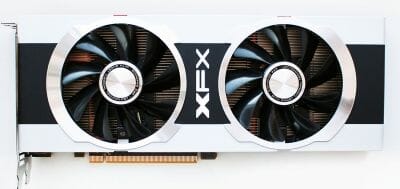
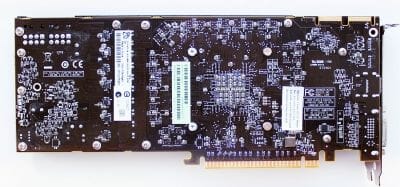
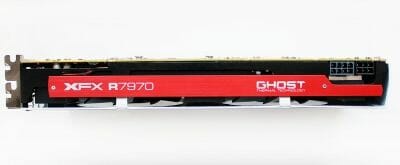
The back side of the PCB is open, just like with the reference Radeon HD 7970, so you should be careful when handling it. The device measures 270 x 100 x 38 millimeters.
Like the reference sample, the card offers one dual-link DVI-I, one HDMI version 1.4a, and two DisplayPorts version 1.2.
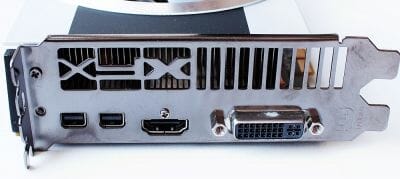
The XFX-shaped vent grid makes the card’s identity easily recognizable.
Like the reference sample, the XFX card has 8- and 6-pin power connectors, two MIO connectors for CrossFireX configurations and a BIOS switch.
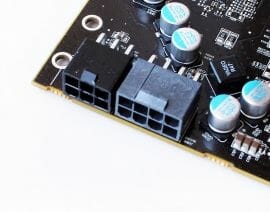
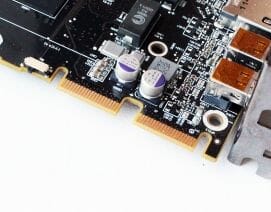
The peak power consumption of the Radeon HD 7970 is 250 watts in 3D mode. It is 70 watts in 2D mode and 3 watts when the monitor is turned off.
The XFX R7970 Double Dissipation Edition uses the reference PCB we examined in our first Radeon HD 7970 review.
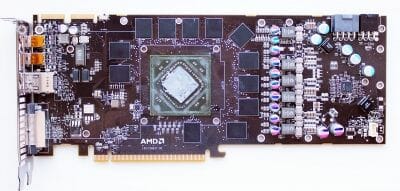
Like the reference Radeon HD 7970, the XFX card is equipped with a 5+1 power system based on DirectFETs with five phases for the GPU and one phase for the memory chips.
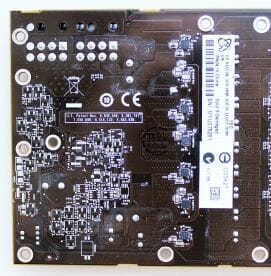
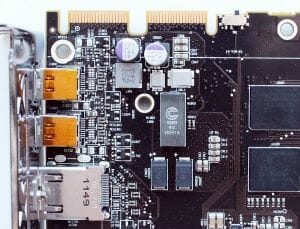
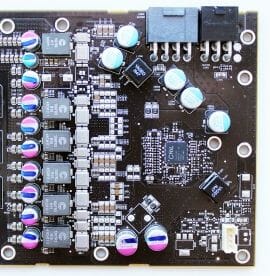
The power system is managed by a CHiL CHL8228G controller which lacks a heatsink and is not even cooled by air flow on the XFX card.
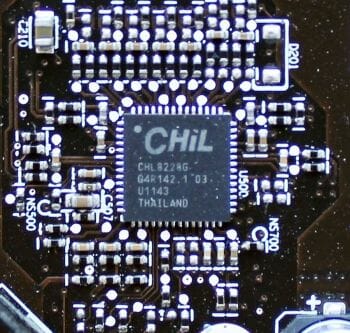
The previous tester took the protective frame of the 28nm GPU off and forgot to glue it back on.
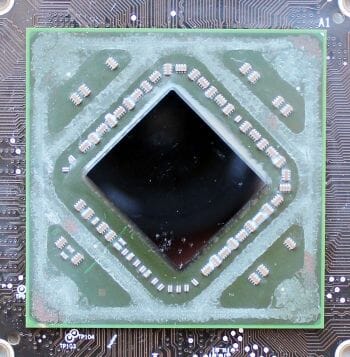
The GPU looks so exposed without it. The GPU configuration is standard for a Radeon HD 7970: 2048 unified shader processors, 32 raster operators and 128 texture-mapping units. As opposed to other XFX products, the R7970 Double Dissipation Edition has the same clock rate as the reference card: 925 MHz at 1.112 volts in 3D mode and 300 MHz at 0.85 volts in 2D mode. The XFX card has a lower voltage than the reference Radeon HD 7970 we tested earlier.
The XFX R7970 Double Dissipation Edition is equipped with 3 gigabytes of GDDR5 memory in 12 FCFBGA-packaged chips located on the face side of the PCB. Manufactured by Hynix Semiconductor, the chips are labeled H5GQ2H24MFR R0C:
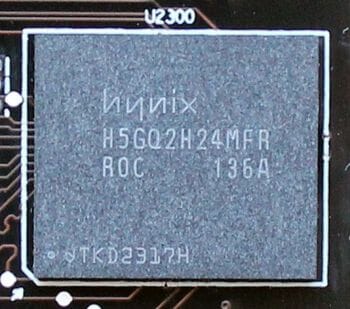
They have a frequency of 5500 MHz at a voltage of 1.6 volts in 3D mode. The memory bus being 384 bits wide, this means a bandwidth of 264 GB/s. The memory clock rate is lowered to 600 MHz in 2D mode.
Thus, the XFX R7970 Double Dissipation Edition has the same specs as the reference AMD Radeon HD 7970:
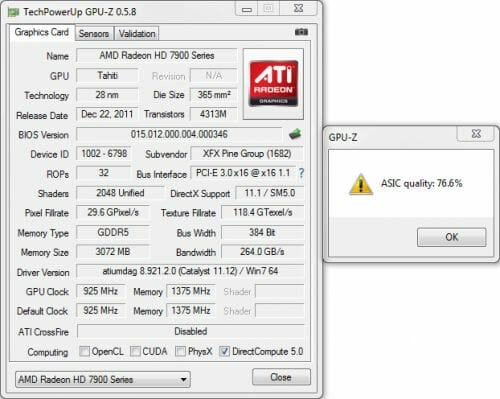
The ASIC Quality screenshot on the right can be evoked from GPU-Z’s context menu and is individual for each graphics card and GPU. This feature has been developed for Nvidia’s Fermi (GX10x and GF11x) and AMD’s Southern Islands chips (Radeon HD 78xx and HD 79xx) and is supposed to indicate the quality of the specific GPU, in percent, based on electrical leakage data. The GPU of our sample of the card has an ASIC quality of 76.6%. The higher this number, the lower voltage the GPU needs to work at the default clock rate and the higher overclocking results you can get with it by increasing its voltage.
According to Alexey Nikolaichuk (the author of RivaTuner and MSI Afterburner), the correlation between voltage and quality is like follows:
- ASIC quality < 75% – 1.1750 V;
- ASIC quality < 80% – 1.1125 V;
- ASIC quality < 85% – 1.0500 V;
- ASIC quality < 90% – 1.0250 V;
- ASIC quality ≤ 100% – 1.0250 V.
The GPU of our sample of the XFX card matches this correlation well enough.
Cooling System and Noise Level
The XFX R7970 Double Dissipation Edition is equipped with an original cooling system that combines two exclusive features: GHOST and Double Dissipation. The former helps the air flow cover as much of the card’s PCB as possible and exhaust the hot air to the outside. The latter, mentioned in the card’s own name, works together with the former and refers to the two fans.
We must note, however, that the PCB actually gets very little of air flow because two thirds of the heatsink’s base are a vapor chamber and the remaining third is blocked by the curved-in ends of the aluminum fins.
Thus, the PCB and its power components are only cooled by the black metallic frame with thermal pads.There is thermal grease between the GPU die and the cooler’s copper sole. The latter isn’t finished well, by the way.
The whole arrangement is cooled by two 9-blade 84mm fans which are PWM-regulated in a speed range of 1400 to 3600 RPM (according to monitoring tools).
We checked out the card’s temperature while running Aliens vs. Predator (2010) in five cycles at the highest settings (2560×1600, with 16x anisotropic filtering and 4x full-screen antialiasing). We used MSI Afterburner 2.2.0 Beta 11 and GPU-Z 0.5.8 as monitoring tools. This test was carried out with a closed system case at an ambient temperature of 25°C. We used Arctic MX-4 thermal interface for the card’s GPU.
When the fans are controlled automatically, the GPU has a peak temperature of 77°C. This is 8°C lower than the GPU temperature of a reference Radeon HD 7970 under the same conditions. That’s good. The result can even be called excellent considering that the fan speed is only 1900 RPM. The cooler is quite audible at that speed, yet the reference cooler is much louder at its 2650 RPM. At the maximum speed of the two fans the GPU temperature of the XFX R7970 Double Dissipation Edition lowers to 61°C, but that’s too noisy.
We measured the level of noise using an electronic noise-level meter CENTER-321 in a closed room about 20 sq. meters large. The noise-level meter was set on a tripod at a distance of 15 centimeters from the graphics card which was installed on an open testbed. The mainboard with the graphics card was placed at an edge of a desk on a foam-rubber tray.
The bottom limit of our noise-level meter is 29.8 dBA whereas the subjectively comfortable (not low, but comfortable) level of noise when measured from that distance is about 36 dBA. The speed of the graphics card’s fans was being adjusted by means of a controller that changed the supply voltage in steps of 0.5 V. We’ve included the results of the Sapphire Radeon HD 6970 Dual Fan into the next diagram as that card features one of the quietest alternative coolers.
The noise graph of the XFX R7970 Double Dissipation Edition is close to that of the reference AMD Radeon HD 7970. However, the fans of the XFX card work at lower speeds under load, making it much quieter than the reference card. The Sapphire Radeon HD 6970 Dual Fan is in its turn quieter than the XFX R7970 Double Dissipation Edition throughout the entire speed range.
Overclockability
Our sample of the XFX R7970 Double Dissipation Edition is a typical HD 7970 in terms of overclockability. We could increase its GPU clock rate from 925 to 1140 MHz (+23.2%) and its memory clock rate from 5500 to 7160 MHz (+30.2%).
We could not reach higher GPU frequencies while increasing the voltage from the default 1.112 to 1.300 volts even though the card could pass some tests (such as 3DMark Vantage and Unigine Heaven) at 1250 MHz and 1.24 volts. It did show visual artifacts in Aliens vs. Predator (2010), Metro 2033: The Last Refuge and some other games, so we had to roll back to the frequency we had achieved at the default GPU voltage.
When overclocked, the card grew a mere 2°C hotter in terms of GPU temperature while its fan speed increased by 130 RPM.
We guess the cooler performs excellently compared to the reference one, especially considering the huge difference in noisiness.
Power Consumption
We measured the power consumption of computer systems with different graphics cards using a multifunctional panel Zalman ZM-MFC3 which can report how much power a computer (the monitor not included) draws from a wall socket. There were two test modes: 2D (editing documents in Microsoft Word and web surfing) and 3D (the benchmark from Metro 2033: The Last Refuge at 2560×1600 with maximum settings).
Despite the lower GPU voltage, the XFX R7970 Double Dissipation Edition needs about as much power as the reference AMD Radeon HD 7970. The difference of 4 watts is negligible and may even be due to some measurement inaccuracies. The system with two Radeon HD 7970s in CrossFireX mode consumes about 215-220 watts more than the system with one such card. Take note that the second card of the CrossFire configuration is just turned off in 2D mode, reducing the power draw to the level of the systems with only one graphics card inside. That’s a handy power-saving feature implemented in the new Radeon HD 7970s.
Testbed Configuration and Testing Methodology
Starting today we are going to upgrade our testbed with a new Intel X79 Express based mainboard, a powerful LGA 2011 processor, fast system memory and a new SSD drive. As a result our testbed features the following configuration:
- Mainboard: Intel Siler DX79SI (Intel X79 Express, LGA 2011, BIOS 0380 from 11/28/2011);
- CPU: Intel Core i7-3960X Extreme Edition, 3.3 GHz, 1.2 V, 6 x 256 KB L2, 15 MB L3 (Sandy Bridge-E, C1, 32 nm);
- CPU cooler: Phanteks PH-TC14PE (2 x 140 mm fans at 900 RPM);
- Thermal interface: ARCTIC MX-4;
- System memory: DDR3 4 x 4GB Mushkin Redline (Spec: 2133 MHz / 9-11-10-28 / 1.65 V);
- Graphics cards:
- AMD Radeon HD 7970 3 GB/384 bit GDDR5, 925/5500 MHz;
- XFX R7970 Double Dissipation Edition 3 GB/384 bit GDDR5, 925/5500 MHz;
- System drive: Crucial m4 256 GB SSD (SATA-III,CT256M4SSD2, BIOS v0009);
- Drive for programs and games: Western Digital VelociRaptor (300GB, SATA-II, 10000 RPM, 16MB cache, NCQ) inside Scythe Quiet Drive 3.5” HDD silencer and cooler;
- Backup drive: Samsung Ecogreen F4 HD204UI (SATA-II, 2 TB, 5400 RPM, 32 MB, NCQ);
- System case: Antec Twelve Hundred (front panel: three Noiseblocker NB-Multiframe S-Series MF12-S2 fans at 1020 RPM; back panel: two Noiseblocker NB-BlackSilentPRO PL-1 fans at 1020 RPM; top panel: standard 200 mm fan at 400 RPM);
- Control and monitoring panel: Zalman ZM-MFC3;
- Power supply: Xigmatek “No Rules Power” NRP-HC1501 1500 W (with a default 140 mm fan);
- Monitor: 30” Samsung 305T Plus.
Since we already compared the performance of AMD Radeon HD 7970 against that of other graphics cards in our previous article, today we will test these two graphics cards in CrossFireX mode.
In order to lower the dependence of the graphics cards performance on the overall platform speed, I overclocked our 32 nm six-core CPU with the multiplier set at 37x, BCLK frequency set at 125 MHz and “Load-Line Calibration” enabled to 4.625 GHz. The processor Vcore was increased to 1.45 V in the mainboard BIOS.
Hyper-Threading technology was enabled. 16 GB of system DDR3 memory worked at 2.133 GHz frequency with 9-11-10-28 timings and 1.65V voltage.
The test session started on January 25, 2012. All tests were performed in Microsoft Windows 7 Ultimate x64 SP1 with all critical updates as of that date and the following drivers:
- Intel Chipset Drivers 9.3.0.1019 WHQL from 12/22/2011 for the mainboard chipset;
- DirectX End-User Runtimes libraries from November 30, 2010;
- AMD Catalyst 11.12 (8.921.2 RC11) driver from 01/25/2012 + Catalyst Application Profile (CAP3) from 01.18.2012 for AMD based graphics cards.
The graphics cards were tested in two resolutions: 1920×1080 and 2560×1600. The tests were performed in two image quality modes: “Quality+AF16x” – default texturing quality in the drivers with enabled 16x anisotropic filtering and “Quality+ AF16x+MSAA4(8)x” with enabled 16x anisotropic filtering and full screen 4x anti-aliasing (MSAA) or 8x if the average framerate was high enough for comfortable gaming experience. We enabled anisotropic filtering and full-screen anti-aliasing from the game settings or configuration files. If the corresponding options were missing, we changed these settings in the Control Panels of Catalyst and GeForce drivers. We also disabled Vsync there. There were no other changes in the driver settings.
We resumed the use of Crysis 2 game as well as added a new test in Battlefield 3. Moreover, we updated the popular StarCraft 2: Wings of Liberty strategy and recorded a new test scene. So, now the list of games and applications used in this test session includes two popular semi-synthetic benchmarking suites, one technical demo and 15 games of various genres:
- 3DMark Vantage (DirectX 10) – version 1.0.2.1, Performance and Extreme profiles (only basic tests);
- 3DMark 2011 (DirectX 11) – version 1.0.3.0, Performance and Extreme profiles;
- Unigine Heaven Demo (DirectX 11) – version 2.5, maximum graphics quality settings, tessellation at “extreme”, AF16x, 1920×1080 resolution with MSAA 4x;
- S.T.A.L.K.E.R.: Call of Pripyat (DirectX 11) – version 1.6.02, Enhanced Dynamic DX11 Lighting profile with all parameters manually set at their maximums, we used our custom cop03 demo on the Backwater map;
- Left 4 Dead 2 (DirectX 9) – version 2.0.8.8, maximum graphics quality settings, d81 demo (two runs) on “Gold Stream (Beta)” map of the “Alpine Greek” level;
- Metro 2033: The Last Refuge (DirectX 10/11) – version 1.2, maximum graphics quality settings, official benchmark, “High” image quality settings; tesselation, DOF and MSAA4x disabled; AAA aliasing enabled, two consecutive runs of the “Frontline” scene;
- Just Cause 2 (DirectX 11) – version 1.0.0.2, maximum quality settings, Background Blur and GPU Water Simulation enabled, two consecutive runs of the “Dark Tower” demo;
- Aliens vs. Predator (2010) (DirectX 11) – Texture Quality “Very High”, Shadow Quality “High”, SSAO On, two test runs in each resolution;
- Lost Planet 2 (DirectX 11) – version 1.0, maximum graphics quality settings, motion blur enabled, performance test “B” (average in all three scenes);
- StarCraft 2: Wings of Liberty (DirectX 9) – version 1.4.2, all image quality settings at “Extreme”, Physics at “Ultra”, reflections On, two 2-minute runs of our own “bench2” demo;
- Sid Meier’s Civilization V (DirectX 11) – version 1.0.1.348, maximum graphics quality settings, two runs of the “diplomatic” benchmark including five heaviest scenes;
- Tom Clancy’s H.A.W.X. 2 (DirectX 11) – version 1.04, maximum graphics quality settings, shadows On, tessellation Off (not available on Radeon), two runs of the test scene;
- Total War: Shogun 2 (DirectX 11) – version 2.0, built in benchmark (Sekigahara battle) at maximum graphics quality settings;
- Crysis 2 (DirectX 11) – version 1.9, we used Adrenaline Crysis 2 Benchmark Tool v.1.0.1.13. BETA with “Ultra High” graphics quality profile and activated HD textures, two runs of a demo recorded on “Times Square” level;
- DiRT 3 (DirectX 11) – version 1.2, built-in benchmark at maximum graphics quality settings on the “Aspen” track;
- Hard Reset Demo (DirectX 9) – benchmark built into the demo version with Ultra image quality settings, one test run;
- Batman: Arkham City (DirectX 11) – version 1.2, maximum graphics quality settings, physics disabled, two sequential runs of the benchmark built into the game.
- Battlefield 3 (DirectX 11) – version 1.3, all image quality settings set to “Ultra”, two successive runs of a scripted scene from the beginning of the “Going Hunting” mission 110 seconds long.
If the game allowed recording the minimal fps readings, they were also added to the charts. We ran each game test or benchmark twice and took the best result for the diagrams, but only if the difference between them didn’t exceed 1%. If it did exceed 1%, we ran the tests at least one more time to achieve repeatability of results.
Performance Tests
3DMark Vantage
When it comes to benchmarking top-end cards like Radeon HD 7970, 3DMark Vantage depends too much on the performance of the platform at large, which is especially conspicuous with the CrossFireX configuration. Our six-core CPU overclocked to 4,625 MHz and fast system memory can’t help. The CrossFireX config is only 40% ahead of the single card in Performance mode but the gap grows to 78% in Extreme mode.
3DMark 2011
The more recent version of 3DMark allows the tandem of the fastest single-GPU cards to show their best: the CrossFireX configuration is 81% and 95% ahead of the single card in the two test modes. That’s closer to our expectations.
Unigine Heaven Demo
The two Radeon HD 7970s are even faster than the single card in Unigine Heaven: by 95% and more. Let’s see what we have in real games, though.
S.T.A.L.K.E.R.: Call of Pripyat
Purchasing two Radeon HD 7970s for S.T.A.L.K.E.R.: Call of Pripyat makes sense if you run the game at the highest settings and at a resolution of 2560×1600. You’ll get twice the frame rate of the single card then. The performance boost from CrossFireX is smaller (20-60%) at 1920×1080 or when full-screen antialiasing is turned off.
Left 4 Dead 2
Despite the high average frame rate, the CrossFireX configuration built out of two top-end graphics cards can provide performance benefits in this game, too. It is 26 to 84% faster than the single card. But of course the single Radeon HD 7970 is also more than enough with its 116 fps at 2560×1600 with 8x MSAA.
Metro 2033: The Last Refuge
The game produced the same results irrespective of whether we enabled FSAA or not. Therefore we tested the graphics cards without FSAA.
The CrossFireX configuration built out of two Radeon HD 7970s may come in handy in Metro 2033: The Last Refuge where the average frame rate increases by 71% and more, making the game playable at 2560×1600. We should note that the bottom speed remains the same as with the single card, though. The new card’s driver obviously needs polishing off.
Just Cause 2
CrossFireX technology is very effective here, our configuration being 96 to 100% faster than the single Radeon HD 7970. There were no visual artifacts, either.
Aliens vs. Predator (2010)
The two Radeon HD 7970s perform superbly in Aliens vs. Predator (2010), too. The performance boost varies from 91 to 98%. Judging by the average frame rates, the single Radeon HD 7970 may be not enough to make this game run smoothly at 2560×1600, so the CrossFireX configuration is indeed useful.
Lost Planet 2
Lost Planet 2 prefers Nvidia-based products, so the CrossFireX configuration is not much faster than the single card: +45-52% at 1920×1080 and +66-72% at 2560×1600.
StarCraft II: Wings of Liberty
The CPU-dependent StarCraft II: Wings of Liberty can only show the benefits of CrossFireX at 2560×1600 where the two Radeon HD 7970s are 83-97% faster than the single card. At 1920×1080 the CrossFireX configuration is limited by the performance of our testbed.
Sid Meier’s Civilization V
AMD’s multi-GPU technology shows its best in Sid Meier’s Civilization V, boosting the frame rate twofold. We doubt anyone would consider buying two Radeon HD 7970s just for the sake of playing this strategy, though.
Tom Clancy’s H.A.W.X. 2
CrossFireX technology is efficient in this test, too. We get a 95% performance boost compared to the single card.
Total War: Shogun 2
The performance boost in CrossFireX mode is high here, too: +85-97% at 1920×1080 and +95-98% at 2560×1600. But, unlike Sid Meier’s Civilization V and Tom Clancy’s H.A.W.X. 2, Total War: Shogun 2 can put the two cards to good use, running smoothly even at high resolutions with 4x MSAA.
Crysis 2
A couple of Radeon HD 7970s is going to come in handy in Crysis 2 if your monitor supports resolutions above 1920×1080. CrossFireX technology is 65 to 72% efficient at 1920×1080 and 92 to 94% efficient at 2560×1600. Unfortunately, the bottom frame rate does not grow up proportionally to the average speed.
DiRT 3
The CrossFire configuration is highly efficient in DiRT 3. It doubles both the bottom and average frame rate compared to the single card.
Hard Reset Demo
The CrossFireX configuration is unstable here. Its advantage over the single card varies from 16 to 95%.
Batman: Arkham City
The Radeon HD 7970 CrossFireX configuration is erratic in Batman: Arkham City, its performance fluctuating from -14% to +42% relative to the single card. We couldn’t solve this problem by choosing different CrossFireX modes and the appropriate profile in the Catalyst control panel.
Battlefield 3
The CrossFireX configuration behaves erratically in Battlefield 3, too. Besides occasional hang-ups when loading the game, the pair of Radeon HD 7970s do not offer much in terms of performance. They are not any faster than the single such card at 2560×1600, for example.
Performance Summary
The diagram below compares two Radeon HD 7970s in CrossFireX mode with a single such card, the latter serving as a baseline.
The summary diagram makes it clear where CrossFireX technology works well and where the Catalyst driver and game-specific profiles need polishing off. The performance benefits are huge in such games as Just Cause 2, Aliens vs. Predator (2010), Sid Meier’s Civilization V, Tom Clancy’s H.A.W.X. 2, Total War: Shogun 2, Crysis 2, DiRT 3, in the AA mode of S.T.A.L.K.E.R.: Call of Pripyat, in Unigine Heaven and in the heavier modes of both versions of 3DMark.
On the other hand, CrossFireX is inefficient in Batman: Arkham City, Battlefield 3 and Hard Reset. You can see that such games are few and we can expect the situation to improve as the Catalyst driver gets optimized. We guess we will test this CrossFireX configuration once again in half a year to check this out.
Conclusion
The XFX R7970 Double Dissipation Edition graphics card seems to have but one downside. Its accessories are too scanty for a top-end $550 product. Otherwise, we can hardly find any other issues, even though the high potential of the original cooler is not fully utilized. The cooler is anyway better and quieter than the reference one. The XFX R7970 Double Dissipation Edition overclocks like any other HD 7970 and delivers the same performance because it has the same PCB and clock rates as the reference HD 7970. So, it is a well-made product with an original cooler that costs about the same money as ordinary HD 7970s.
Running two Radeon HD 7970s in CrossFireX mode only makes sense at very high settings such as 2560×1600 with 8x or 4x antialiasing. If the game (or benchmark) supports CrossFireX correctly, you can double your frame rate and enjoy smoother graphics. The downside is that CrossFireX technology doesn’t work correctly in each game. And even if it does, there can be problems with the bottom frame rate. Hopefully, this is only because the Tahiti processor is new, so its CrossFireX compatibility will improve in the near future.